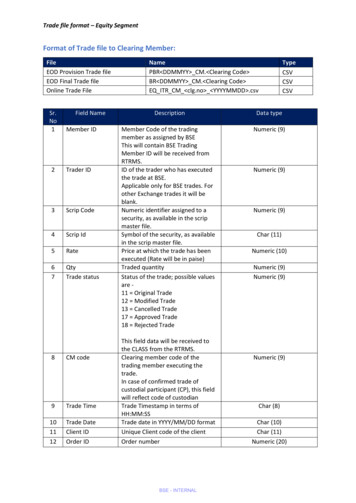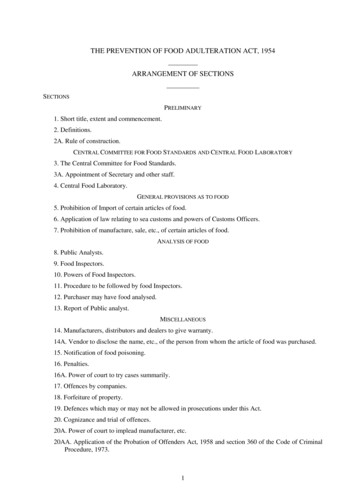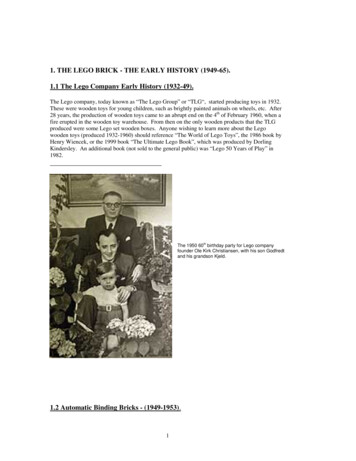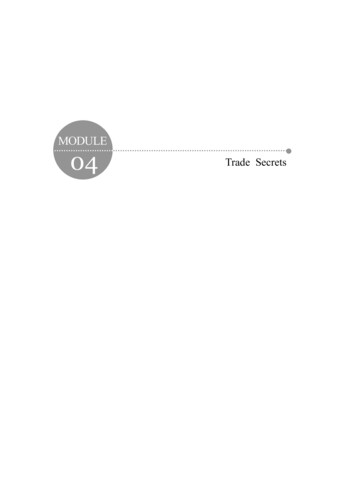
Transcription
SERVING THE TRADE SINCE 1954SCAFFOLDINGPANELS AND ACCESSORIESMANUFACTURED FROM HIGH STRENGTH STEEL TUBEPERIMETER JOINTS COPED AND WELDEDPLATED/PAINTED FINISH ON PANEL LOCKSALL PANELS DRILLED FOR EASY PINNINGALL PANELS HAVE POWDER COATED FINISHSca1ffold 12 " WellWheelt:;,; ; gf tJGuard Rail& Posts ! : : . . 1Access Ladderwith Brackets:' 8" Locking CasterAdjustableLeg 2 OF THESE2 OF THESE 4 OF THESECOUPLING PINS WITHSPRING RETAINER INSTALLED, BASIC UNIT"f Follow all applicable ANSI, OSHA, etc. codes and regulations for use of this equipmentAll drawings are for illustration purposes only. Copyright 2016 ABLE Scaffold , LLC.ABLE Scaffold. LLC7475 NW 63rd StreetMiami, FL 33166 3603Miami: (305) 592 5940Fax: (305) 592 2793USA: 1 800 831 4564WEB SITE: www.AbleScaffold.comE MAIL: Sales @AbleScaffold .comLINK: www.Andamio.ws
@nmPANELSScaffold60" WIDE C C*42" WIDE C C*36" WIDE C C* 24" WIDE C C* ' . WALKTHRUPANELWALKTHRUPANELP 4264WP 364W42" WIDE x 6'4" HIGHWALKTHRUPANELP 4255P 564W24" WI DE x 6' HIGHALSO AVAILABLE42" WI DE x 5' HIGH60" WI DE x 6'4" HIGHP 260536'WIDE x6'4' HIGHP340536" WIDE x 4' HIGHP 424542" WI DE x4' HIGH. ALSO AVAILABLE.P4267WBLUE LINE42" WIDE x 6'7" HIGH,460" WIDE C C*r . ' 160" WIDE C C* hI '::C,1'' ,. 'P 555'. . . :60" WI DE x 5' HIGHALSO AVAILABLE WI THZINC COATINGFL 1P 5645FAST LOCK60" WIDE x 6'4" HIGHCOUPLING PIN WITHSPRING RETAINERINSTALLEDCOUPLING PIN FOR ALL PANELSSEE BOTTOM OF PAGE FOR DIFFERENTLOCKING OPTIONS60" WIDE C C*II. :.1,.; :.;'flP 535M!C. 60" WIDE C C*P 545iP 525. 1 :.I"'!I!:.11/!:"l.ll" . C /\CP SRGPTSPRING RETAINERGRAVITY PIGTAIL PIN*C C Center to Center.60" WIDE x 2' HIGH60" WIDE x 4' HIGH:.k'/J:iIi60" WI DE x 3' HIGH.60 " WIDE C C* uLJCP TPCP 1TOGGLE PINCOUPLING PINFollow all applicable ANSI , OSHA, etc. codes and regulations for use of this equipmentAll drawings are for illustration purposes only. Copyright 2017 ABLE Scaffold, LLC . 2
BRACESDIAGONAL BRACE(Legend: ' B' for ' Brace' ## inches between locks 5', 7' or 10' length)OUTSIDEHANDRAILSTAIR SECTIONSR 50ORSR 64ORSR 5SR 64 'B 36 7XB 36 10XB 36 48 1 OX DOUBLE HOLESTAIR SECTIONS FOR5' AND 6'4" PANELSINSIDEHANDRAILSR 50IRSR 64IRCAT A CORNER BRACEB 57 DImportant Rule: When assembling rolling tower, alwa;'s use CAT A CORNER braceson the Ranels sections. This prevents the tower from racking' (getting out of square).CAT A CORNER braces must be used at the bottom and at every 20'.GUARD RAIL2', 3', 42", 5', 7' OR 10' SPANGR 2GR 5GR 7GR 84DGR 10GUARD RAIL POSTiGRPWITHOUTKICKERGRPKWITH KICKERFollow all applicable ANSI , OSHA, etc. codes and regulations for use of this equipmentAll drawings are for illustration purposes only. Copyrigh t 2017 ABLE Scaffold , LLC. 3
TUBING CLAMPS AND ACCESSORIES,MORTAR BOARD AND BAKER/ [ffi] 'if.STYLE PRODUCTS FOR INDOOR USE.RillY]ScaffoldTUBE & CLAMPTC RA (1 BOLT)TC SWRIGHT ANGLESCAFFOLD WRENCHREVERSING RATCHETEXPANDABLE JOINT PINTC RAT (T BOLT)RIGHT ANGLEMBSMORTAR BOARDSTANDTHE BASIC "ALL PURPOSE UNIT" (APUW)Featuring the integratedspring loaded pin systemfor fast assembly and"no su rprises" operation.PORTABLE FOLD UP MINI SCAFFOLDSPESU66 FOOT PORTABLEFOLD UP MINIAll steel construction 6' long platform of 5/8" plywood ,adjusts every 4" Locking , swivel casters are 5" weig ht over center Bu ilt to easily fit through standard doors.(Guardrails and outriggers, as shown below, are soldseparately.) 1,000 lb capacity.APUGRS. ·ocr.· · 4 FOOT PORTABLEFOLD UP MINIAPUORSSMALLOUTRIGGERAPUW :f n THEALLBASIC r aPUPOSEUN IT75"APUORLLARGEOUTRIGGERBoth the 6' 3" and the 4' 4" models of the Porta bleFold Up Mini Scaffold feature strong 1" (2.5 cm)outside diameter tubula r steel frames and anelectrostatica lly applied epoxy coating.The 6" model is 75" tall , including the housing forthe 5" wheels , 73" wide and 29" deep. Three14 gauge (2 mm) solid steel scaffold planks arestandard . The 4" model is 52" tall, including the housing forthe 4" wheels , 42.5" wide and 21 " deep. Two 14gauge (2 mm) solid steel planks.73"Follow all applicable ANSI, OSHA, etc. codes and regulations for use of this equipmentAll drawings are for illustration purposes only. Copyright 2017 ABLE Scaffold , LLC. 4
ACCESSORIESScaffoldSIDE BRACKETOUTRIGGERACCESS LADDERAL 5AL 65' OR 6 LADDERWELL WHEELHA WW1212" heavy duty Well Wheelfor up to 1" rope to hoistmaterials.ALBCATWALKHOIST ARMACCESSLADDERBRACKETCW 7A7' SPANHA 1Fits over coupling pin on frame., (Maximum capacity 250 lbs.)360 swivel.2 BRACKETS/LADDER2 BOLTS/BRACKETCATWALKCW 7AACW 10AA7' OR 10' SPAN8" LOCKINGCASTERAll AluminumFrame and DeckC 8U HEADSUH 15UH 256" X 11 "8.5"x 11 "Important Rule: Always lock wheel andpin caster stem before and during use.ADJUSTABLE LEGSBASE PLATEBP 1AL PAL 5Follow all applicable ANSI , OSHA, etc. codes and regulations for use of this equipmentAll drawings are for illustration purposes only. Copyright 2017 ABLE Scaffold, LLC. 5 AL BP
GIVE TO ERECTOR/USER OR POST ON JOB SITECode of Safe Practices for: Frame Scaffolds, System Scaffolds, Tube and Clamp Scaffolds & Rolling ScaffoldsDeveloped for Industry by THE SCAFFOLDING, SHORING & FORMING INSTITUTE (SSFI)and THE SCAFFOLD & ACCESS INDUSTRY ASSOCIATION , INC . (SAIA)It shall be the responsibility of all users to read and comply with the following common sense guidelines which are designed to promote safety in the erecting ,dismantling, alteration and use of Scaffolds. These guidelines do not pu rpo rt to be all inclusive nor to supplant or replace other traditional safety and precautionarymeasures. If these guidelines in any way conflict with any state, local, provincial , federal or other government statute or regu lation , said statute or regulation shallsupersede these guidelines and it shall be the responsibility of each user to comply therewith .GENERAL GUIDELINESA. POST THESE SCAFFOLD SAFETY GUIDELINES in a conspicuous place and besure that all persons who erect, dismantle, or use scaffolds are aware of them . Usethem in tool box safety meetings.B. COMPLY WITH ALL STATE, LOCAL AND FEDERAL CODES , ORDINANCES ANDREGULATIONS pertaining to scaffolds.C. SURVEY THE JOB SITE . A survey shall be made of the job site by a competentperson for hazards, such as non compacted earth fills, ditches, debris, electrical lines,unguarded openings, and other hazardous conditions created by other trades. Theseconditions should be corrected or avoided as noted in the following sections.D. INSPECT ALL EQUIPMENT BEFORE EACH USE. Never use any scaffold componentthat is damaged or defective. Mark it or tag it as damaged or defective and removeit from service.E. ERECT SCAFFOLDS IN ACCORDANCE WITH DESIGN AND/OR MANUFACTURERSRECOMMENDATIONS .F. DO NOT ERECT, DISMANTLE OR ALTER A SCAFFOLD except under thesupervision of a competent person qualified in scaffold construction .G. DO NOT ABUSE OR MISUSE THE SCAFFOLD.H. MAINTAIN THE SCAFFOLD IN A SAFE CONDITION . Stop work and report anyunsafe conditions to your supervisor.I. NEVER TAKE CHANCES ! If in doubt regarding the safety, or use of the scaffold,consult a qualified person .J. NEVER USE THE SCAFFOLD FOR PURPOSES OR IN WAYS FOR WHICH ITWAS NOT DESIGNED.K. DO NOT WORK ON SCAFFOLDS if you are physical unable to do so.L. DO NOT WORK UNDER THE IN FLUENCE of alcohol or drugs.M. FALL PROTECTION Never work on a scaffold that has open sided platforms; usea guardrail or personal fall protection system when required by applicable codes orsite requirements.N. DO NOT ERECT, DISMANTLE, ALTER OR WORK ON SCAFFOLDS DURINGSTORMS OR HIGH WINDS, AS DETERMINED BY THE COMPETENT PERSON .II. GUIDELINES FOR ERECTION AND USE OF SCAFFOLDSA. STATIONARY SCAFFOLD LEGS SHALL BE SET ON BASE PLATES ON ANADEQUATE FIRM FOUNDATION . Install sills as necessary to distribute the leg loadsto the foundation; secure base plates to the sills as required . Any part of a buildingor structure used to support the scaffold shall be capable of supporting the maximumintended load .B. USE ADJUSTING SCREWJACKS or other approved methods to adjust to unevengrade conditions.C. BRACING , LEVELI NG & PLUMBING OF SCAFFOLDS1. Plumb and level all scaffolds as erection proceeds. Do not force scaffoldcomponents together.2. Each frame or panel shall be braced by horizontal bracing , cross bracing,diagonal bracing or a combination thereof for securing vertical members togetherlaterally. All brace connections shall be properly secured , in accordance with themanufacturer's recommendations .3. Install bracing as erection proceeds, in accordance with the manufacturer'srecommendations.4. Joints shall be secured as required to prevent separation .D. MAKE SURE SCAFFOLDS ARE STABLE. Free standing scaffolds exceeding theallowable height to base ratio must be restrained from tipping .E. SECURE THE SCAFFOLD TO A SUBSTANTIAL STRUCTURE, when the scaffoldexceeds the maximum allowable height. Ties must prevent the scaffold from tippingeither into or away from the structure. Install ties as close as practicable wherehorizontal members connect to vertical legs.F. WHEN SCAFFOLDS ARE FULLY OR PARTIALLY ENCLOSED, or when scaffoldsare subjected to overturning forces, additional ties may be required ; consult aqualified person.G, DO NOT ERECT OR USE SCAFFOLD NEAR LIVE POWERLINES unless properprecautions are taken . Consult the power service company for advice .H. INSTALL SAFE ACCESS FOR ALL SCAFFOLD PLATFORMS. This includes ladders,stairways, direct access , ramps and walkways. Do not climb scaffold componentsnot intended for access, such as braces, rosettes , rings, cups and clamps.I. PROVIDE A GUARDRAIL OR PERSONAL FALL PROTECTION SYSTEM when theplatform height exceeds unprotected limits. (Check applicable regulations forpermissible unprotected limits, but never more than 10 feet.)IA. INSTALL FALLING OBJECT PROTECTION when required by regulations.ASOCITN SCAF LOs1 INOUSTRYJ, BRACKETS AND CANTILEVERE D PLATFORMS1. Cantilevered scaffolds platforms shall be installed and used as designed by a qualifiedperson.2. All scaffold brackets shall be installed and used in accordance with manufacturer'srecommendations. Brackets are to be used only as work platforms and shall not beused for storage of material or equipment unless designed for such use by a qualifiedengineer.K. SCAFFOLD COMPONENTS shall be installed and used in accordance with thequalified person's design. Components shall not be altered . Scaffold components frommore than one manufacturer shall not be intennixed, unless the component parts haveequivalent strength , readily fit together and the resulting scaffold's structural integrityis maintained .L. PLATFORMS1. Scaffold platforms shall be at least 18 inches wide. Only planking and decking meetingscaffold use requirements shall be used. Platforms shall be properly supported.2. Check each platform prior to use. Make sure platform units are not warped ,damaged, or otherwise unsafe.3. Planks shall have at least 12" overlap unless restrained.4. Planks including Solid sawn lumber, Laminated lumber, modular, composite , orfabricated scaffold planks and platforms shall extend over their end supports notless than 6" unless restrained. Excess overhang is prohibited unless barricaded toprevent access. .5. Do not store materials or accumulate debris that could overload the scaffold .M. FOR "PUTLOGS"AND "TRUSSES" THE FOLLOWING ADDITIONALGUIDELINES APPLY:1. Install and brace putlogs and trusses in accordance with the design.2. Do not cantilever or extend putlogs/trusses except as designed by a qualified person.N. FOR ROLLING SCAFFOLDS THE FOLLOWING ADDITIONAL GUIDELINES APPLY:1. RIDING A ROLLING SCAFFOLD IS VERY HAZARDOUS. The SSFI and theSAIA, DO NOT recommend nor encourage this practice.2. Rolling scaffolds should be used on hard level surfaces.3. Casters with plain stems shall be secured to the frames or adjustment screws bypins or other suitable means.4. A minimum 12 inches of screwjack shall extend into the scaffold leg or securedfrom sliding out.5. Wheels or casters shall be locked to prevent caster rotation and scaffold movementwhen scaffold is in use.6. Joints shall be restrained from separation.7. Use horizontal diagonal bracing or equivalent means near the bottom and at 20foot intervals measured from the rolling surface .8. Do not use brackets or other platform extensions without compensating for theoverturning effect.9. Secure or remove all materials and equipment from platform before moving the scaffold.10. Do not attempt to move a rolling scaffold without sufficient help watch out forholes in floor and overhead obstructions. Stabilize against tipping.0 . SAFE USE OF SCAFFOLD1. Prior to use, inspect scaffold to insure it has not been altered and is in a safe workingcondition regardless of what the tag might state.2. Erected scaffolds and platforms should be inspected regularly by those using themprior to each work shift and after any occurrences that may alter the scaffold froma safe condition.3. Exercise caution when entering or exiting a work platform.4. Do not overload scaffold. Follow manufacture s safe working load recommendationsand the design.5. Do not jump onto platforms.6. DO NOT USE ladders or makeshift devices to increase the working height of ascaffold . Do not plank guardrails to increase the height of a scaffold .7. Use proper access.111. WHEN DISMANTLING SCAFFOLDING THE FOLLOWING GUIDELINES APPLY:A. Inspect the scaffold to make sure it is structurally stable . If unstable, do not startdismantling the scaffold prior to stabilizing it.B. Do not remove ties until the scaffold has been dismantled to that level.B. Visually inspect platform units prior to dismantling to be sure they are safe and secure .C. Do not remove a scaffold component without considering the effect of that removal.D. Do not accumulate excess components or equipment on the level being dismantled.E. Lower dismantled components in an orderly manner. Do not throw off the scaffold .F. Dismantled equipment should be stockpiled in an orderl y manner.G. Defective components must be tagged and kept separate . !JOINED 1972 1 6 ScaffoldCopyright 2017 ABL E Scaffold, LLC. 5/ 17 1000
1. Plumb and level all scaffolds as erection proceeds. Do not force scaffold 9. Secure or remove all materials and equipment from platform before moving the scaffold. components together. 10. Do not attempt to move a rolling scaffold without sufficient help watch out for 2.











